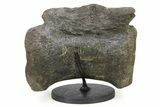This Specimen has been sold.
5" Tyrannosaur (Gorgosaurus?) Caudal Vertebra with Stand - Montana
This is a beautifully preserved, 5" wide tyrannosaur (Gorgosaurus libratus?) caudal vertebra collected from the Two Medicine Formation of Montana. It was collected this last summer from our partner's private lease and has been nicely prepared from the hard rock surrounding it. The centrum is overall in great condition with some minor weathering along the edges. The neural canal remained intact along with portions of the prezygapophyses.
It sits beautifully on the included custom metal display stand.
There are three described tyrannosaurid species found in the Two Medicine formation (Daspletosaurus horneri, Daspletosaurus wilsoni, and Gorgosaurus libratus). An isolated vertebra would probably be indistinguishable between the three species. But based on prevalence of material found at the quarry it is believed this most likely Gorgosaurus libratus.
There are a couple small spots of gap fill restoration.
It sits beautifully on the included custom metal display stand.
There are three described tyrannosaurid species found in the Two Medicine formation (Daspletosaurus horneri, Daspletosaurus wilsoni, and Gorgosaurus libratus). An isolated vertebra would probably be indistinguishable between the three species. But based on prevalence of material found at the quarry it is believed this most likely Gorgosaurus libratus.
There are a couple small spots of gap fill restoration.
Gorgosaurus was a large Tyrannosaurid carnivore from the Late Cretaceous of western North America living around 76-75 million years ago. During this time it coexisted with the similarly sized tyrannosaur Daspletosaurus. Both tyrannosaurs measured 25-30 feet and around 3 tons at adult size. How they coexisted is not quite clear, but what is known is that the more slender albertosaurine Gorgosaurus seemed to prefer the northern latitudes, while Daspletosaurus was more common in southern localities. As a tyrannosaur, Gorgosaurus was a carnivore with small arms and strong jaws. In addition, Gorgosaurus and the related Albertosaurus have been found fossilized in small groups, suggesting that these more gracile species may have mobbed their prey.
About The Two Medicine Formation
The Two Medicine Formation is a geographical formation in Central Montana and Southern Alberta, Canada. The formation is predominantly sandstone laid down by rivers and deltas during the Campanian Age of the Cretaceous, about 80-75 million years ago. Approximately two thousand feet thick on the western edge, it lies on top of the Virgelle Sandstone formation and under the Bearpaw Shale. It is located between the Front Range of the Rocky Mountains and the Sweetgrass Arch, a tectonic fold feature 40-90 miles east of the Front Range.
The Two Medicine is the same age as the Judith River Formation found further east. It was laid down further inland from the Western Interior Seaway, while the Judith River Formation was deposited along the coast. The Two Medicine contains much of the same dinosaur fauna, but fewer reptiles, amphibians, and aquatic fossils.
The Two Medicine Formation is a geographical formation in Central Montana and Southern Alberta, Canada. The formation is predominantly sandstone laid down by rivers and deltas during the Campanian Age of the Cretaceous, about 80-75 million years ago. Approximately two thousand feet thick on the western edge, it lies on top of the Virgelle Sandstone formation and under the Bearpaw Shale. It is located between the Front Range of the Rocky Mountains and the Sweetgrass Arch, a tectonic fold feature 40-90 miles east of the Front Range.
The Two Medicine is the same age as the Judith River Formation found further east. It was laid down further inland from the Western Interior Seaway, while the Judith River Formation was deposited along the coast. The Two Medicine contains much of the same dinosaur fauna, but fewer reptiles, amphibians, and aquatic fossils.
SPECIES
Gorgosaurus libratus?
LOCATION
Pondera County, Montana
FORMATION
Two Medicine Formation
SIZE
Size: 5 x 3.85 x 2.4", Height on stand: 4.3" tall
CATEGORY
SUB CATEGORY
ITEM
#284749
We guarantee the authenticity of all of our specimens.
 Reviews
Reviews














